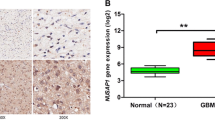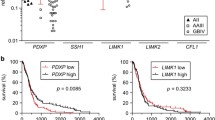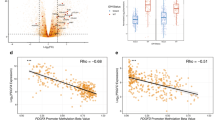Abstract
In search of novel genes associated with glioma pathogenesis, we have previously shown frequent deletions of the KIAA1797/FOCAD gene in malignant gliomas, and a tumor suppressor function of the encoded focadhesin impacting proliferation and migration of glioma cells in vitro and in vivo. Here, we examined an association of reduced FOCAD gene copy number with overall survival of patients with astrocytic gliomas, and addressed the molecular mechanisms that govern the suppressive effect of focadhesin on glioma growth. FOCAD loss was associated with inferior outcome in patients with isocitrate dehydrogenase 1 or 2 (IDH)-mutant astrocytic gliomas of WHO grades II–IV. Multivariate analysis considering age at diagnosis as well as IDH mutation, MGMT promoter methylation, and CDKN2A/B homozygous deletion status confirmed reduced FOCAD gene copy number as a prognostic factor for overall survival. Using a yeast two-hybrid screen and pull-down assays, tubulin beta-6 and other tubulin family members were identified as novel focadhesin-interacting partners. Tubulins and focadhesin co-localized to centrosomes where focadhesin was enriched in proximity to centrioles. Focadhesin was recruited to microtubules via its interaction partner SLAIN motif family member 2 and reduced microtubule assembly rates, possibly explaining the focadhesin-dependent decrease in cell migration. During the cell cycle, focadhesin levels peaked in G2/M phase and influenced time-dependent G2/M progression potentially via polo like kinase 1 phosphorylation, providing a possible explanation for focadhesin-dependent cell growth reduction. We conclude that FOCAD loss may promote biological aggressiveness and worsen clinical outcome of diffuse astrocytic gliomas by enhancing microtubule assembly and accelerating G2/M phase progression.





Similar content being viewed by others
References
Aoki K, Nakamura H, Suzuki H, Matsuo K, Kataoka K, Shimamura T, Motomura K, Ohka F, Shiina S, Yamamoto T, Nagata Y, Yoshizato T, Mizoguchi M, Abe T, Momii Y, Muragaki Y, Watanabe R, Ito I, Sanada M, Yajima H, Morita N, Takeuchi I, Miyano S, Wakabayashi T, Ogawa S, Natsume A (2018) Prognostic relevance of genetic alterations in diffuse lower-grade gliomas. Neuro Oncol 20:66–77. https://doi.org/10.1093/neuonc/nox132
Bailey MH, Tokheim C, Porta-Pardo E, Sengupta S, Bertrand D, Weerasinghe A, Colaprico A, Wendl MC, Kim J, Reardon B, Kwok-Shing Ng P, Jeong KJ, Cao S, Wang Z, Gao J, Gao Q, Wang F, Liu EM, Mularoni L, Rubio-Perez C, Nagarajan N, Cortés-Ciriano I, Zhou DC, Liang WW, Hess JM, Yellapantula VD, Tamborero D, Gonzalez-Perez A, Suphavilai C, Ko JY, Khurana E, Park PJ, Van Allen EM, Liang H, MC3 Working Group, Cancer Genome Atlas Research Network, Lawrence MS, Godzik A, Lopez-Bigas N, Stuart J, Wheeler D, Getz G, Chen K, Lazar AJ, Mills GB, Karchin R, Ding L (2018) Comprehensive characterization of cancer driver genes and mutations. Cell 174:1034–1035. https://doi.org/10.1016/j.cell.2018.07.034
Bouchet BP, Noordstra I, van Amersfoort M, Katrukha EA, Ammon YC, Ter Hoeve ND, Hodgson L, Dogterom M, Derksen PW, Akhmanova A (2016) Mesenchymal cell invasion requires cooperative regulation of persistent microtubule growth by SLAIN2 and CLASP1. Dev Cell 39:708–723. https://doi.org/10.1016/j.devcel.2016.11.009
Brockschmidt A, Trost D, Peterziel H, Zimmermann K, Ehrler M, Grassmann H, Pfenning PN, Waha A, Wohlleber D, Brockschmidt FF, Jugold M, Hoischen A, Kalla C, Waha A, Seifert G, Knolle PA, Latz E, Hans VH, Wick W, Pfeifer A, Angel P, Weber RG (2012) KIAA1797/FOCAD encodes a novel focal adhesion protein with tumour suppressor function in gliomas. Brain 135:1027–1041. https://doi.org/10.1093/brain/aws045
Cancer Genome Atlas Research Network, Brat DJ, Verhaak RG, Aldape KD, Yung WK, Salama SR et al (2015) Comprehensive, integrative genomic analysis of diffuse lower-grade gliomas. N Engl J Med 372:2481–2498. https://doi.org/10.1056/NEJMoa1402121
Ceccarelli M, Barthel FP, Malta TM, Sabedot TS, Salama SR, Murray BA, Morozova O, Newton Y, Radenbaugh A, Pagnotta SM, Anjum S, Wang J, Manyam G, Zoppoli P, Ling S, Rao AA, Grifford M, Cherniack AD, Zhang H, Poisson L, Carlotti CG Jr, Tirapelli DP, Rao A, Mikkelsen T, Lau CC, Yung WK, Rabadan R, Huse J, Brat DJ, Lehman NL, Barnholtz-Sloan JS, Zheng S, Hess K, Rao G, Meyerson M, Beroukhim R, Cooper L, Akbani R, Wrensch M, Haussler D, Aldape KD, Laird PW, Gutmann DH, TCGA Research Network, Noushmehr H, Iavarone A, Verhaak RG (2016) Molecular profiling reveals biologically discrete subsets and pathways of progression in diffuse glioma. Cell 164:550–563. https://doi.org/10.1016/j.cell.2015.12.028
Cheng MW, Wang BC, Weng ZQ, Zhu XW (2012) Clinicopathological significance of Polo-like kinase 1 (PLK1) expression in human malignant glioma. Acta Histochem 114:503–509. https://doi.org/10.1016/j.acthis.2011.09.004
Ciciarello M, Mangiacasale R, Casenghi M, Zaira Limongi M, D’Angelo M, Soddu S, Lavia P, Cundari E (2001) p53 displacement from centrosomes and p53-mediated G1 arrest following transient inhibition of the mitotic spindle. J Biol Chem 276:19205–19213. https://doi.org/10.1074/jbc.M009528200
Cirillo L, Gotta M, Meraldi P (2017) The elephant in the room: the role of microtubules in cancer. Adv Exp Med Biol 1002:93–124. https://doi.org/10.1007/978-3-319-57127-0_5
Danovi D, Folarin A, Gogolok S, Ender C, Elbatsh AM, Engström PG, Stricker SH, Gagrica S, Georgian A, Yu D, Harvey KJ, Ferretti P, Paddison PJ, Preston JE, Abbott NJ, Bertone P, Smith A, Pollard SM (2013) A high-content small molecule screen identifies sensitivity of glioblastoma stem cells to inhibition of polo-like kinase 1. PLoS One 8:e77053. https://doi.org/10.1371/journal.pone.0077053
Dietzmann K, Kirches E, von Bossanyi Jachau K, Mawrin C (2001) Increased human polo-like kinase-1 expression in gliomas. J Neurooncol 53:1–11. https://doi.org/10.1023/A:1011808200978
Dikovskaya D, Newton IP, Näthke IS (2004) The adenomatous polyposis coli protein is required for the formation of robust spindles formed in CSF Xenopus extracts. Mol Biol Cell 15:2978–2991. https://doi.org/10.1091/mbc.E03-08-0613
Dong J, Park SY, Nguyen N, Ezhilarasan R, Martinez-Ledesma E, Wu S, Henry V, Piao Y, Tiao N, Brunell D, Stephan C, Verhaak R, Sulman E, Balasubramaniyan V, de Groot JF (2018) The polo-like kinase 1 inhibitor volasertib synergistically increases radiation efficacy in glioma stem cells. Oncotarget 9:10497–10509. https://doi.org/10.18632/oncotarget.24041
Etienne-Manneville S (2013) Microtubules in cell migration. Annu Rev Cell Dev Biol 29:471–499. https://doi.org/10.1146/annurev-cellbio-101011-155711
Gjertsen BT, Schöffski P (2015) Discovery and development of the Polo-like kinase inhibitor volasertib in cancer therapy. Leukemia 29:11–19. https://doi.org/10.1038/leu.2014.222
Hein MY, Hubner NC, Poser I, Cox J, Nagaraj N, Toyoda Y, Gak IA, Weisswange I, Mansfeld J, Buchholz F, Hyman AA, Mann M (2015) A human interactome in three quantitative dimensions organized by stoichiometries and abundances. Cell 163:712–723. https://doi.org/10.1016/j.cell.2015.09.053
Horpaopan S, Spier I, Zink AM, Altmüller J, Holzapfel S, Laner A, Vogt S, Uhlhaas S, Heilmann S, Stienen D, Pasternack SM, Keppler K, Adam R, Kayser K, Moebus S, Draaken M, Degenhardt F, Engels H, Hofmann A, Nöthen MM, Steinke V, Perez-Bouza A, Herms S, Holinski-Feder E, Fröhlich H, Thiele H, Hoffmann P, Aretz S (2015) Genome-wide CNV analysis in 221 unrelated patients and targeted high-throughput sequencing reveal novel causative candidate genes for colorectal adenomatous polyposis. Int J Cancer 136:E578–E589. https://doi.org/10.1002/ijc.29215
Hsu LC, White RL (1998) BRCA1 is associated with the centrosome during mitosis. Proc Natl Acad Sci USA 95:12983–12988. https://doi.org/10.1073/pnas.95.22.12983
Juanes MA, Bouguenina H, Eskin JA, Jaiswal R, Badache A, Goode BL (2017) Adenomatous polyposis coli nucleates actin assembly to drive cell migration and microtubule-induced focal adhesion turnover. J Cell Biol 216:2859–2875. https://doi.org/10.1083/jcb.201702007
Körber V, Yang J, Barah P, Wu Y, Stichel D, Gu Z, Fletcher MNC, Jones D, Hentschel B, Lamszus K, Tonn JC, Schackert G, Sabel M, Felsberg J, Zacher A, Kaulich K, Hübschmann D, Herold-Mende C, von Deimling A, Weller M, Radlwimmer B, Schlesner M, Reifenberger G, Höfer T, Lichter P (2019) Evolutionary trajectories of IDHWT glioblastomas reveal a common path of early tumorigenesis instigated years ahead of initial diagnosis. Cancer Cell 35:692–704. https://doi.org/10.1016/j.ccell.2019.02.007
Koncar RF, Chu Z, Romick-Rosendale LE, Wells SI, Chan TA, Qi X, Bahassi EM (2017) PLK1 inhibition enhances temozolomide efficacy in IDH1 mutant gliomas. Oncotarget 8:15827–15837. https://doi.org/10.18632/oncotarget.15015
Korshunov A, Casalini B, Chavez L, Hielscher T, Sill M, Ryzhova M, Sharma T, Schrimpf D, Stichel D, Capper D, Reuss DE, Sturm D, Absalyamova O, Golanov A, Lambo S, Bewerunge-Hudler M, Lichter P, Herold-Mende C, Wick W, Pfister SM, Kool M, Jones DTW, von Deimling A, Sahm F (2019) Integrated molecular characterization of IDH-mutant glioblastomas. Neuropathol Appl Neurobiol 45:108–118. https://doi.org/10.1111/nan.12523
Krämer A, Mailand N, Lukas C, Syljuåsen RG, Wilkinson CJ, Nigg EA, Bartek J, Lukas J (2004) Centrosome-associated Chk1 prevents premature activation of cyclin-B-Cdk1 kinase. Nat Cell Biol 6:884–891. https://doi.org/10.1038/ncb1165
Krepischi AC, Achatz MI, Santos EM, Costa SS, Lisboa BC, Brentani H, Santos TM, Gonçalves A, Nóbrega AF, Pearson PL, Vianna-Morgante AM, Carraro DM, Brentani RR, Rosenberg C (2012) Germline DNA copy number variation in familial and early-onset breast cancer. Breast Cancer Res 14:R24. https://doi.org/10.1186/bcr3109
LaPak KM, Burd CE (2014) The molecular balancing act of p16(INK4a) in cancer and aging. Mol Cancer Res 12:167–183. https://doi.org/10.1158/1541-7786.MCR-13-0350
Louis DN, Ohgaki H, Wiestler OD, Cavenee WK (2007) World Health Organization histological classification of tumours of the central nervous system. International Agency for Research on Cancer, Lyon
Louis DN, Ohgaki H, Wiestler OD, Cavenee WK (2016) World Health Organization histological classification of tumours of the central nervous system. International Agency for Research on Cancer, Lyon
Macůrek L, Lindqvist A, Lim D, Lampson MA, Klompmaker R, Freire R, Clouin C, Taylor SS, Yaffe MB, Medema RH (2008) Polo-like kinase-1 is activated by aurora A to promote checkpoint recovery. Nature 455:119–123. https://doi.org/10.1038/nature07185
Natrajan R, Mackay A, Lambros MB, Weigelt B, Wilkerson PM, Manie E, Grigoriadis A, Ahern R, van der Groep P, Kozarewa I, Popova T, Mariani O, Turajlic S, Furney SJ, Marais R, Rodruigues DN, Flora AC, Wai P, Pawar V, McDade S, Carroll J, Stoppa-Lyonnet D, Green AR, Ellis IO, Swanton C, van Diest P, Delattre O, Lord CJ, Foulkes WD, Vincent-Salomon A, Ashworth A, Henri Stern M, Reis-Filho JS (2012) A whole-genome massively parallel sequencing analysis of BRCA1 mutant oestrogen receptor-negative and -positive breast cancers. J Pathol 227:29–41. https://doi.org/10.1002/path.4003
Nigg EA, Schnerch D, Ganier O (2017) Impact of centrosome aberrations on chromosome segregation and tissue architecture in cancer. Cold Spring Harb Symp Quant Biol 82:137–144. https://doi.org/10.1101/sqb.2017.82.034421
Osswald M, Jung E, Sahm F, Solecki G, Venkataramani V, Blaes J, Weil S, Horstmann H, Wiestler B, Syed M, Huang L, Ratliff M, Karimian Jazi K, Kurz FT, Schmenger T, Lemke D, Gömmel M, Pauli M, Liao Y, Häring P, Pusch S, Herl V, Steinhäuser C, Krunic D, Jarahian M, Miletic H, Berghoff AS, Griesbeck O, Kalamakis G, Garaschuk O, Preusser M, Weiss S, Liu H, Heiland S, Platten M, Huber PE, Kuner T, von Deimling A, Wick W, Winkler F (2015) Brain tumour cells interconnect to a functional and resistant network. Nature 528:93–98. https://doi.org/10.1038/nature16071
Pihan GA, Purohit A, Wallace J, Knecht H, Woda B, Quesenberry P, Doxsey SJ (1998) Centrosome defects and genetic instability in malignant tumors. Cancer Res 58:3974–3985
Reifenberger G, Weber RG, Riehmer V, Kaulich K, Willscher E, Wirth H, Gietzelt J, Hentschel B, Westphal M, Simon M, Schackert G, Schramm J, Matschke J, Sabel MC, Gramatzki D, Felsberg J, Hartmann C, Steinbach JP, Schlegel U, Wick W, Radlwimmer B, Pietsch T, Tonn JC, von Deimling A, Binder H, Weller M, Loeffler M, Network German Glioma (2014) Molecular characterization of long-term survivors of glioblastoma using genome- and transcriptome-wide profiling. Int J Cancer 135:1822–1831. https://doi.org/10.1002/ijc.28836
Reifenberger G, Wirsching HG, Knobbe-Thomsen CB, Weller M (2017) Advances in the molecular genetics of gliomas—implications for classification and therapy. Nat Rev Clin Oncol 14:434–452. https://doi.org/10.1038/nrclinonc.2016.204
Riehmer V, Gietzelt J, Beyer U, Hentschel B, Westphal M, Schackert G, Sabel MC, Radlwimmer B, Pietsch T, Reifenberger G, Weller M, Weber RG, Loeffler M, Network German Glioma (2014) Genomic profiling reveals distinctive molecular relapse patterns in IDH1/2 wild-type glioblastoma. Genes Chromosomes Cancer 53:589–605. https://doi.org/10.1002/gcc.22169
Roy DM, Walsh LA, Desrichard A, Huse JT, Wu W, Gao J, Bose P, Lee W, Chan TA (2016) Integrated genomics for pinpointing survival loci within arm-level somatic copy number alterations. Cancer Cell 29:737–750. https://doi.org/10.1016/j.ccell.2016.03.025
Sbalzarini IF, Koumoutsakos P (2005) Feature point tracking and trajectory analysis for video imaging in cell biology. J Struct Biol 151:182–195. https://doi.org/10.1016/j.jsb.2005.06.002
Seki A, Coppinger JA, Jang CY, Yates JR, Fang G (2008) Bora and the kinase Aurora a cooperatively activate the kinase Plk1 and control mitotic entry. Science 320:1655–1658. https://doi.org/10.1126/science.1157425
Shirahata M, Ono T, Stichel D, Schrimpf D, Reuss DE, Sahm F, Koelsche C, Wefers A, Reinhardt A, Huang K, Sievers P, Shimizu H, Nanjo H, Kobayashi Y, Miyake Y, Suzuki T, Adachi JI, Mishima K, Sasaki A, Nishikawa R, Bewerunge-Hudler M, Ryzhova M, Absalyamova O, Golanov A, Sinn P, Platten M, Jungk C, Winkler F, Wick A, Hänggi D, Unterberg A, Pfister SM, Jones DTW, van den Bent M, Hegi M, French P, Baumert BG, Stupp R, Gorlia T, Weller M, Capper D, Korshunov A, Herold-Mende C, Wick W, Louis DN, von Deimling A (2018) Novel, improved grading system(s) for IDH-mutant astrocytic gliomas. Acta Neuropathol 136:153–166. https://doi.org/10.1007/s00401-018-1849-4
Stehbens S, Wittmann T (2012) Targeting and transport: how microtubules control focal adhesion dynamics. J Cell Biol 198:481–489. https://doi.org/10.1083/jcb.201206050
van der Vaart B, Manatschal C, Grigoriev I, Olieric V, Gouveia SM, Bjelic S, Demmers J, Vorobjev I, Hoogenraad CC, Steinmetz MO, Akhmanova A (2011) SLAIN2 links microtubule plus end-tracking proteins and controls microtubule growth in interphase. J Cell Biol 193:1083–1099. https://doi.org/10.1083/jcb.201012179
Vaubel RA, Caron AA, Yamada S, Decker PA, Eckel Passow JE, Rodriguez FJ, Nageswara Rao AA, Lachance D, Parney I, Jenkins R, Giannini C (2018) Recurrent copy number alterations in low-grade and anaplastic pleomorphic xanthoastrocytoma with and without BRAF V600E mutation. Brain Pathol 28:172–182. https://doi.org/10.1111/bpa.12495
Venkatachalam R, Verwiel ET, Kamping EJ, Hoenselaar E, Görgens H, Schackert HK, van Krieken JH, Ligtenberg MJ, Hoogerbrugge N, van Kessel AG, Kuiper RP (2011) Identification of candidate predisposing copy number variants in familial and early-onset colorectal cancer patients. Int J Cancer 129:1635–1642. https://doi.org/10.1002/ijc.25821
Vertii A, Hehnly H, Doxsey S (2016) The centrosome, a multitalented renaissance organelle. Cold Spring Harb Perspect Biol 8:a025049. https://doi.org/10.1101/cshperspect.a025049
Weber RG, Bridger JM, Benner A, Weisenberger D, Ehemann V, Reifenberger G, Lichter P (1998) Centrosome amplification as a possible mechanism for numerical chromosome aberrations in cerebral primitive neuroectodermal tumors with TP53 mutations. Cytogenet Cell Genet 83:266–269. https://doi.org/10.1159/000015168
Weller M, Weber RG, Willscher E, Riehmer V, Hentschel B, Kreuz M, Felsberg J, Beyer U, Löffler-Wirth H, Kaulich K, Steinbach JP, Hartmann C, Gramatzki D, Schramm J, Westphal M, Schackert G, Simon M, Martens T, Boström J, Hagel C, Sabel M, Krex D, Tonn JC, Wick W, Noell S, Schlegel U, Radlwimmer B, Pietsch T, Loeffler M, von Deimling A, Binder H, Reifenberger G (2015) Molecular classification of diffuse cerebral WHO grade II/III gliomas using genome- and transcriptome-wide profiling improves stratification of prognostically distinct patient groups. Acta Neuropathol 129:679–693. https://doi.org/10.1007/s00401-015-1409-0
Weller M, van den Bent M, Tonn JC, Stupp R, Preusser M, Cohen-Jonathan-Moyal E, Henriksson R, Le Rhun E, Balana C, Chinot O, Bendszus M, Reijneveld JC, Dhermain F, French P, Marosi C, Watts C, Oberg I, Pilkington G, Baumert BG, Taphoorn MJB, Hegi M, Westphal M, Reifenberger G, Soffietti R, Wick W, European Association for Neuro-Oncology (EANO) Task Force on Gliomas (2017) European Association for Neuro-Oncology (EANO) guideline on the diagnosis and treatment of adult astrocytic and oligodendroglial gliomas. Lancet Oncol 18:e315–e329. https://doi.org/10.1016/S1470-2045(17)30194-8
Weren RD, Venkatachalam R, Cazier JB, Farin HF, Kets CM, de Voer RM, Vreede L, Verwiel ET, van Asseldonk M, Kamping EJ, Kiemeney LA, Neveling K, Aben KK, Carvajal-Carmona L, Nagtegaal ID, Schackert HK, Clevers H, van de Wetering M, Tomlinson IP, Ligtenberg MJ, Hoogerbrugge N, Geurts van Kessel A, Kuiper RP (2015) Germline deletions in the tumour suppressor gene FOCAD are associated with polyposis and colorectal cancer development. J Pathol 236:155–164. https://doi.org/10.1002/path.4520
Acknowledgements
The authors wish to thank Alexander Pfeifer, Institute of Pharmacology and Toxicology, University of Bonn Medical Center and University of Bonn, Bonn, Germany for providing the lentivector construct expressing FOCAD-GFP; Erich Nigg, Biozentrum, University of Basel, Switzerland for helpful scientific discussions; Rudolf Bauerfeind, Research Core Unit for Laser Microscopy, Hannover Medical School, Germany for technical support with regard to live-cell imaging experiments; and the Cell Sorting Core Facility, Hannover Medical School, Germany.
Funding
FB received a grant from the Hochschulinterne Leistungsförderung (HiLF) program at Hannover Medical School. The German Glioma Network was supported by the German Cancer Aid (Stiftung Deutsche Krebshilfe) from 2004 to 2012 (Grant No. 70-3163-Wi 3).
Author information
Authors and Affiliations
Contributions
FB, AC, BH, MiW, and RGW designed research; FB, AF, AC, MB, and CMT performed research; MSR, MaW, TP, AvD, GR, and PC contributed materials, patient/tumor data and expertise; FB, AC, BH, and RGW analyzed data and made figures; FB, AC, BH, MiW, and RGW wrote the manuscript; all authors reviewed and revised the manuscript.
Corresponding author
Ethics declarations
Conflict of interest
GR received research grants from Roche and Merck as well as honoraria for advisory board activities from AbbVie. All other authors report no conflict of interest.
Statement of human and animal rights
The study was approved by the appropriate institutional research ethics committees. All procedures were in accordance with their ethical standards and with the 1964 Helsinki declaration and its later amendments or comparable ethical standards.
Additional information
Publisher's Note
Springer Nature remains neutral with regard to jurisdictional claims in published maps and institutional affiliations.
Manfred Westphal, Torsten Pietsch, Andreas von Deimling, Guido Reifenberger, Bettina Hentschel, and Michael Weller represent the German Glioma Network.
Electronic supplementary material
Below is the link to the electronic supplementary material.
Rights and permissions
About this article
Cite this article
Brand, F., Förster, A., Christians, A. et al. FOCAD loss impacts microtubule assembly, G2/M progression and patient survival in astrocytic gliomas. Acta Neuropathol 139, 175–192 (2020). https://doi.org/10.1007/s00401-019-02067-z
Received:
Revised:
Accepted:
Published:
Issue Date:
DOI: https://doi.org/10.1007/s00401-019-02067-z




